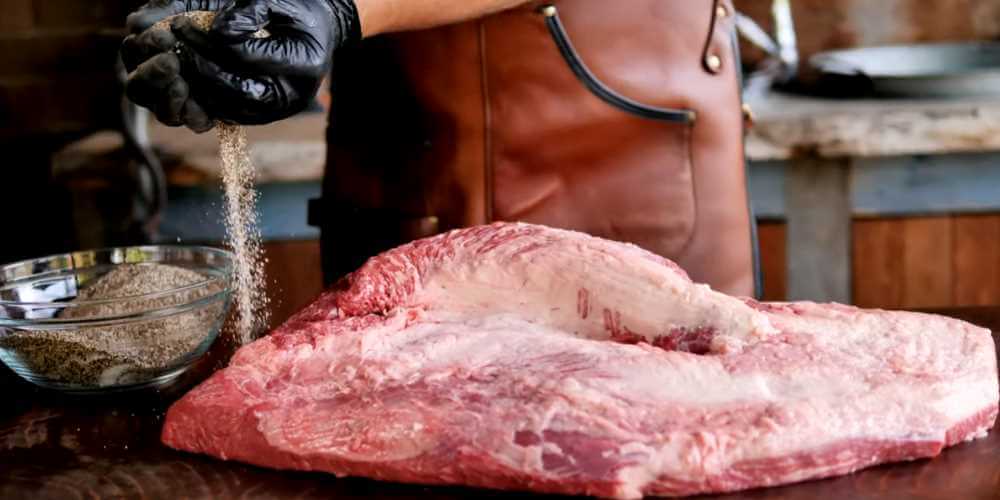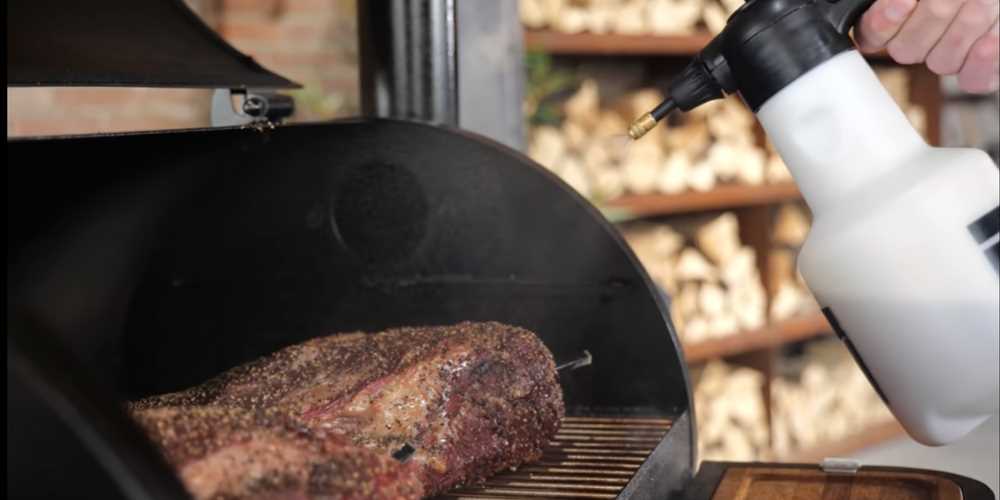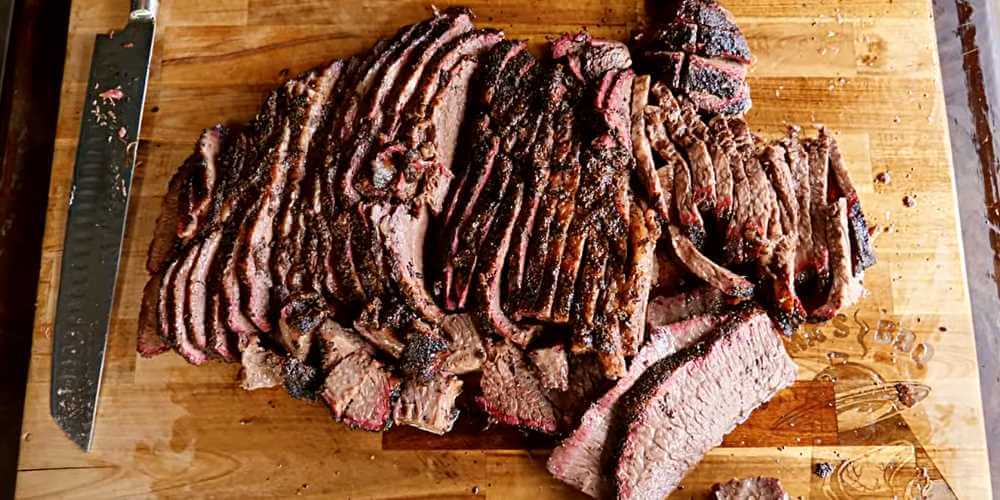What is Beef Brisket and How to Cook It

Beef Brisket is one of the most-loved cuts of beef regarding low and slow cooking. It’s really not hard to figure out why this cut of meat has gained popularity among diners and cooking enthusiasts. You can enjoy Smoked beef brisket, Korean beef stew, Moroccan tagines, Pies, Pot Roasts, and much more. Read on to know the dish about the King of Meats, the Beef Brisket.
What is a Beef Brisket?
Every cut of meat, no matter how tough, can be tenderised and turned tasty with enough time and the appropriate cooking procedure. Beef brisket is a cut that comes from the bottom portion of the cow’s breast or pectoral muscles. The high level of activity in this region results in a tough cut of meat with a high connective tissue content. To achieve the finest results, a slow and low cooking method is recommended. The term “brisket” has been historically used interchangeably with “breast” or “breast meat.” The term “chicken breast” can also be used interchangeably with “chicken brisket,” however no one we know uses this term.
What are the parts of a Beef Brisket?
You want your brisket to be marbled with fat to stay soft and juicy. The point and the flat muscles contribute to the brisket’s overall structure. The brisket’s deckle, or a fatty portion, is the target of the point cut. One of the most delicious cuts of beef is the brisket point, which has an exceptionally soft texture. It has more marbling inside than the flat, so it stays juicy during cooking. The deckle is shaved off the flat cut (or “initial cut”), making it thinner and flatter. You can ask your local butcher to portion the beef brisket so you can get what you need instead of getting the entire piece. You can also order beef brisket online if going to the butcher won’t fit your schedule!
What is a Brisket Fat Cap?
A layer of fat protects the surface of the beef brisket, touching the skin. The term “fat cap” refers to this extra layer of fat. The average thickness of a fat cap is 1 inch; however, this might vary depending on the animal and the method of butchery. The fat cap should be trimmed to a thickness of 1/4 and 1/2 inches before seasoning, but some expert smokers disagree. Your brisket will be much more tender and experience much less surface drying if you use the fat cap as a screen between the fire and the meat.
Where to Buy Beef Brisket?
Like any other cut of beef or any kind of meat, the best place to buy beef brisket is from your neighbourhood butchers. Local butchers in Melbourne such as The Meat Inn Place offer the best prices and the freshest meats because they directly get their supplies from farms that ethically raise their cattle and herds. Plus, you can specify the cuts that you need and you can get great advise while you’re at it!
How to Cook Beef Brisket
There are several approaches to cooking brisket, but all of them require patience and low heat. Butchers at The Meat Inn Place in Melbourne said that because brisket is so tough, it takes a lengthy, slow cook time to achieve the desired tenderness. This method is superior to a rapid, high-temperature cook for producing a tender piece of meat because it breaks down the muscle fibres more thoroughly.
1. Smoking

Beef brisket that has been barbecued to perfection is a work of art. The relaxed, smoke-flavored, delicate beef slices practically melt in your lips. In reality, the technique is rather similar when it comes to brisket, which has fat and collagen that become creamy and delectable when smoked slowly for a long period. With lump charcoal and wood, heat the smoker to 250 degrees Fahrenheit (F). For a sweeter flavour in our brisket, we utilise fruit woods. The flat of the brisket should be monitored more closely when cooking since it is leaner and has a higher internal temperature. A superb brisket should be smoked at 250 degrees F to allow the fat to render gently. At 225, it takes longer than we would like and doesn’t taste or feel significantly different.
2. Brining
Brining is a well-known technique for preserving moisture and making meat taste juicy, tender, and flavorful. Brining is a frequent practice for smoking turkey, pork belly, and other meats. Whether you are preparing your beef brisket for smoking or creating corned beef, it is advised that you brine it beforehand. The salt in brine will flavour the meat and help the brisket maintain moisture during the protracted cooking period. Brisket should only be brined with a dry brine, as opposed to a wet brine.
- Dry Brine: The brisket is salted two to twenty-four hours before smoking in a dry brine. Due to the size of the brisket and the time, it will take the salt to enter the meat; it is preferable to dry brine the day before smoking.
- Wet Brine: In a pot large enough to cover the meat in brine, bring water to a boil while combining all the ingredients for the brine. Ensure that the salt and sugar have dissolved. Submerge the beef brisket in the brine after adding the ice to chill it down. If prefered, brine for two days or longer in a closed refrigerator.
3. Oven-roasting
Brisket can be cooked in the oven, but the smoky flavour that brings out the finest in this piece of meat won’t be there. Some chefs may finish their smoked brisket in the oven to expedite the cooking process.
Brisket should be brined and given a dry rub before being cooked. It’s important to ensure that the meat is flavorful on both sides before serving. Place a rack inside the large roasting pan and preheat the oven to 300 ° f. On top of the rack, crisscross several sheets of foil long enough to cover the brisket loosely. Place the brisket in the centre of the aluminium foil that has been placed in the roasting pan, and fat cap up. Leaving a little gap between the brisket and the foil, bring the aluminium foil together and seal it. The brisket is then loosely covered. Place the brisket in a roasting pan, then tightly cover the pan with foil or a lid. Bake the beef for 1 hour per pound until an instant-read thermometer reads 170 to 180 degrees inside the thickest portion of the meat.
4. Stewing
Beef brisket is a lesser-known cut that is taken from the animal’s chest and sliced lengthwise just below the shoulder. The brisket’s location results in a rather hard piece of meat, and lengthy, slow cooking improves this texture. It also makes it a less expensive cut, making it ideal for family feasts or when you need to feed a lot of people. Although I believe that brisket served whole is always nicer, it can also be oven braised, poached, pot roasted, or sliced into bits for a stew.
How to Store Beef Brisket?
There isn’t much to knowing how to store beef brisket. Raw brisket can be kept in its original packaging in the refrigerator for up to a week or frozen in airtight packaging for up to a year. As with most leftovers, cooked brisket keeps for three to four days in the refrigerator.
Beef Brisket FAQ
Beef brisket does not have any other names. However, it can be called by its main parts, which is the point and the flat.
Chuck roast, which is comparable to brisket in both texture and flavour, is a great alternative. Both of these cuts originate from the cow’s forequarters, which also explains why they are frequently interchangeable.
While whole briskets may weigh up to 9 kilos, you can usually find it sold in half, with the fattier belly end being the more affordable option. Brisket may be purchased at your neighbourhood butcher for an average price of $13 to $27 per kilo. Don’t forget to call your Melbourne butchers to know if they have discounts on beef briskets!
Beef brisket is one of those cuts that can feed an entire household! Depending on its weight, a complete packer brisket should serve 10 to 20 people. A complete packer usually weighs between 12 and 15 pounds, so if you want to serve one pound of raw brisket per person, you’ll have enough meat for 12 to 15 people.
You can go crazy with beef brisket side dishes. It really is sky’s the limit on your options. Here are a few suggestions on what to prepare when you’re having beef brisket roast in your home.
- Coleslaw
- Corn Pudding
- Grilled Vegetables
- Mashed Potatoes
- Roasted Potatoes
- Mac and Cheese
- Brussel Sprouts
- Corn on the cob
- Dinner Rolls
- Baked Beans

